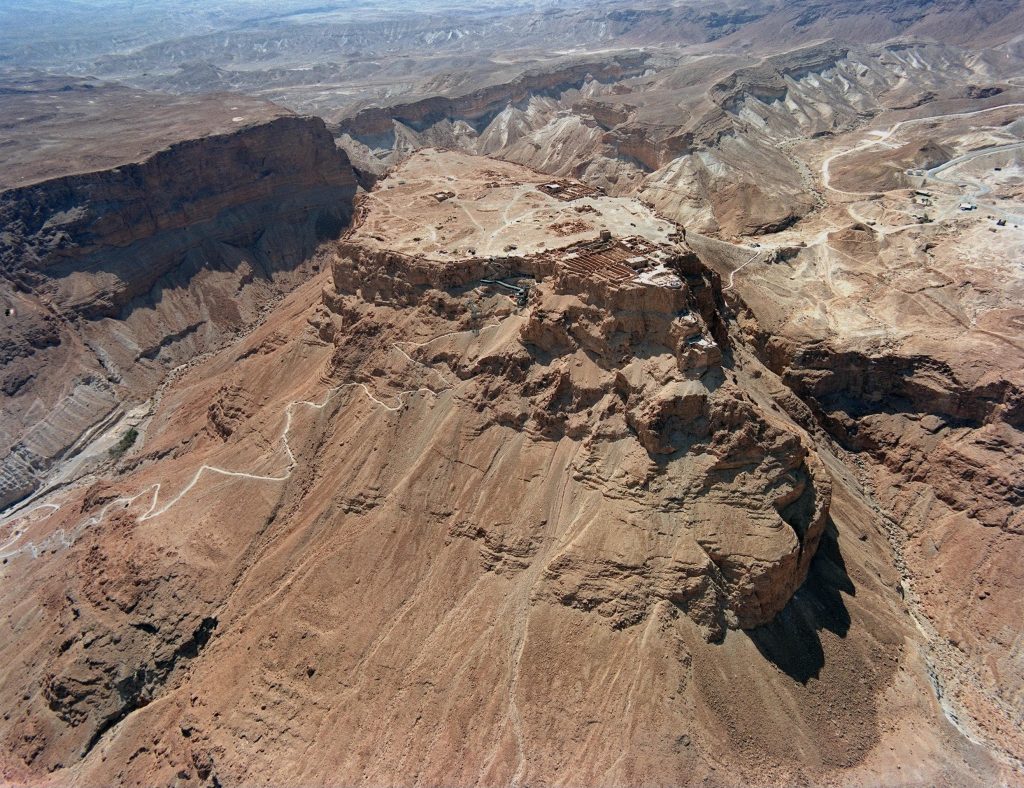Masada was an impressive fortress built upon a plateau to protect Jewish Zealots and refugees from the Romans. The Jews wisely chose this location because of its natural defenses against invaders. They imagined it would be impossible for anyone to besiege the city; the treacherous terrain and great outer wall surrounding Masada surely would protect it. Unfortunately, the Jews underestimated the Roman army.

Masada appeared to be the perfect fortress. Its four vertical sides made it nearly impossible to invade. The largest wall on the eastern side is one hundred forty meters above the desert floor, roughly half the size of the Eiffel Tower. From the east, there is a dangerous zig-zagging trail called the serpent’s path. The western side wall is eighty meters above the desert floor, as tall as the Statue of Liberty. The inhabitants took the extra precaution and built two walls on the perimeter of the plateau about 1400 meters long and six meters tall. The outer wall was 1.4 meters thick and the inner was 1 meter thick. Between the inner and outer wall, there was an empty space. During an invasion they planned to fill the gap with stone, wood, and dirt to strengthen the wall; until then it was used for storage. There were also twenty-meter-tall towers strategically spaced out throughout Masada for defensive reasons.1
The defenders were aware that if one were to attack, the first action the enemy would take would be to stop the water supply. Anticipating that possibility, the defenders built twelve cisterns to hold the water inside the fortress. Along the western slopes they had enough water stored to fill sixteen Olympic pools. It was very forward thinking of the Jews to do this. They also had many food storehouses toward the north. They kept grain, oils, corn, wine, dates, along with other foods. Thanks to the dry climate, storing the food was not a problem. In case they were to run low, the flat land would be ideal to grow additional food. Remains of the wall, tower, cisterns, food storage buildings, and other structures are still visible today.1

Unfortunately, these precautions were no match for the Roman army. In 73 C.E., Flavius Silva marched the Roman army and other troops totaling about 10,000 soldiers south to conquer Masada. Waiting on top of Masada were the 1,000 men (Jewish refugees and Zealots) willing to defend their safe haven. The Romans were aware it would take a significant amount of time to destroy Masada, so they set up camp and had Jewish war prisoners bring a constant supply of food and water. They first stopped up the aqueducts and diverted them for their own use. Next, they constructed a wall around Masada to prevent the inhabitants from escaping, and to cut them off from the outside world, a classic Roman war operation. The wall was three meters high and 3.2 kilometers long, and enforced by eight camps with many other guards posted. This impressive mechanism was built in a matter of days and can still be seen today.1

The Romans knew this would not be a quick victory; they would have to overthrow Masada by force. They came to the conclusion that the only way to reach the top of Masada was by making the steep side into a gradual incline. To do this, they took advantage of a natural spur called the white rock on the western side. It was nearly two hundred meters from the top of Masada to the edge of the natural gulf. The ramp to the top was built at a twenty degree incline. It took months to build the massive ramp. Every day, the inhabitants of Masada would wake up to see the enemy growing closer and closer, with no way for them to escape. As the Romans got close to the top, they became more vulnerable to the defenders. The Jews at the top could now shoot arrows and defend themselves against the Romans. As a result, the Romans had the Jewish war prisoners shield them so that they could shoot back. Within two months, the great ramp was complete. It was two hundred twenty meters long, and archaeologists assume it weighed as much as one and a half empire state buildings.4
The Romans attacked Masada with their siege towers. They rolled the massive towers up the man-made ramp to overthrow Masada. The inhabitants tried to fight back, shooting arrows at the towers and trying to destroy it with fire.4 The day before the final attack, the Romans carefully planned how they would conquer Masada. Early that morning, they charged up the ramp, and over the walls. To their surprise, they were not met with a fight. Instead, they encountered thousands of dead bodies. The few remaining women and children explained to them what had happened. The Jews knew they did not stand a chance against the Roman army of 10,000. They decided it would be better to die than to be conquered. Since Judaism does not allow suicide, they came to the conclusion they would have to kill each other. The men first killed the children and women; then they cast lots to decide who would be killed first, and who would have to be the last to commit suicide. It is ironic how they ignored the sixth commandment not to murder, but decided to alter its meaning to mean not to murder yourself. Despite the confusion, they ultimately chose death over slavery.6
- Encyclopedia Judea, 2007, s.v. “Masada,” by Michael Berenbaum. ↵
- Encyclopedia Judea, 2007, s.v. “Masada,” by Michael Berenbaum. ↵
- Encyclopedia Judea, 2007, s.v. “Masada,” by Michael Berenbaum. ↵
- The Greenhaven Encyclopedia of the Ancient World, 2002, s.v. “Siege of Masada,” by Don Nardo. ↵
- The Greenhaven Encyclopedia of the Ancient World, 2002, s.v. “Siege of Masada,” by Don Nardo. ↵
- Encyclopedia of Death & Human Experiences, 2009, s.v. “Mass Suicide,” by Clifton D. Bryant. ↵



86 comments
Mariana Govea
What an Interesting article! Super fun read!I never even knew the city of Masada existed! I love reading about the Romans I think its super interesting due to that their traditions and customs were so unique and crazy!You did a very good job in describing Masada what it was and how it happened to be, and after reading how hard the Romans worked to built it and conquer it, but to know that they killed each other and they all ended up dying its kinda sad because they did not really have that much time to enjoy something great that they were all looking forward too! Great descriptive visuals and explaining!
Luke Trevino
In times of imprisonment freedom is the only hope one has. So if that hope is taken away there is no reason to carry on! That is what these refugees felt. The would of much rather died then be enslaved! It is interesting to see how the romans adjusted to achieve there goal. I believe it was amazing at how high the city was! It would’ve been cool to know how they decided to go all the way up there. Overall very informative essay.
Erick Paul Martinez
Great article on a great topic. I had no prior knowledge about Masada. It truly was the greatest fortress, a lot of resources were used in preparing for the Roman army. Despite their best efforts they were unable to hold back the Romans and were driven to kill one another. It is bizarre to think that they truly refused to become slaves to the Romans, they preferred to kill their own women, children, and brothers.
Lianna Ybarra
Very well written article! I remember reading about this in high school but it wasn’t as detailed as this was. I think that it’s sad that they put so much time, effort, and thought into building this home for them and ended up having to kill each other. I will say that the Romans were quick to think on their feet by finding a way to get to them when it was made basically impossible to get to them. Overall, I really enjoyed this article!
Hayden Hollinger
I thought this was a very interesting article. I really enjoyed learning about the Masada and was fascinated by the topic and the reasons as to why it was even a thing. This was a well written article and the images used were very good as they helped give a clear illustration on what was being described. I enjoyed learning how the fortress was eventually overcome.
Nicolas McKay
This was a great article Jennifer. I had no idea a fortified city like Masada ever existed. I am amazed that the Romans were able to conquer it, or that they would even be willing to go to the lengths that they did. I wonder if at any point they wondered if it was worth all of the resources they were using towards the campaign. I was also very surprised by the Jews final act of escape. I am not sure what I would have done if I was in their circumstances but I am shocked nonetheless. You did a great job describing the physical layout of the city in the first oart and then telling the story behind it in the second part.